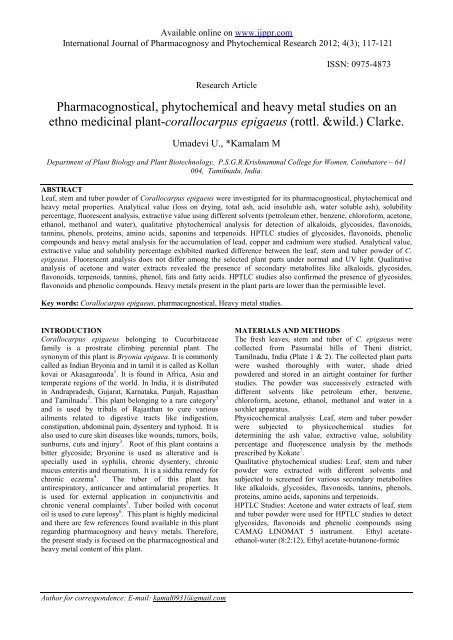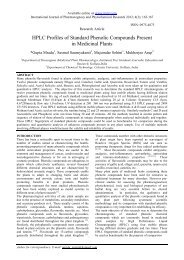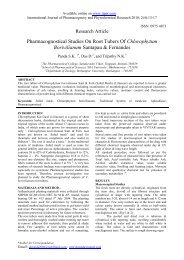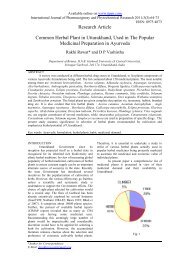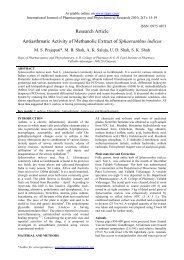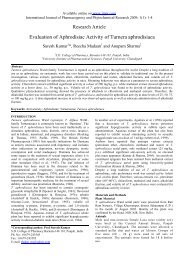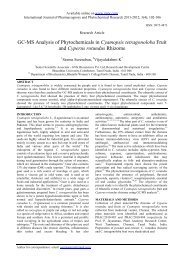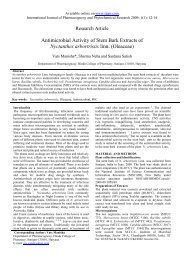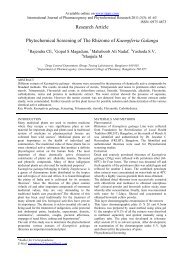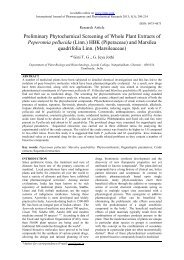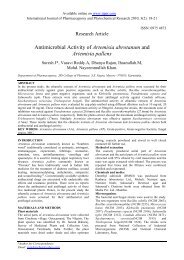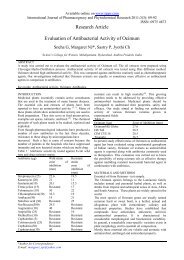Full Text PDF - International Journal of Pharmacognosy and ...
Full Text PDF - International Journal of Pharmacognosy and ...
Full Text PDF - International Journal of Pharmacognosy and ...
Create successful ePaper yourself
Turn your PDF publications into a flip-book with our unique Google optimized e-Paper software.
Available online on www.ijppr.com<br />
<strong>International</strong> <strong>Journal</strong> <strong>of</strong> <strong>Pharmacognosy</strong> <strong>and</strong> Phytochemical Research 2012; 4(3); 117-121<br />
Research Article<br />
ISSN: 0975-4873<br />
Pharmacognostical, phytochemical <strong>and</strong> heavy metal studies on an<br />
ethno medicinal plant-corallocarpus epigaeus (rottl. &wild.) Clarke.<br />
Umadevi U., *Kamalam M<br />
Department <strong>of</strong> Plant Biology <strong>and</strong> Plant Biotechnology, P.S.G.R.Krishnammal College for Women, Coimbatore – 641<br />
004, Tamilnadu, India.<br />
ABSTRACT<br />
Leaf, stem <strong>and</strong> tuber powder <strong>of</strong> Corallocarpus epigaeus were investigated for its pharmacognostical, phytochemical <strong>and</strong><br />
heavy metal properties. Analytical value (loss on drying, total ash, acid insoluble ash, water soluble ash), solubility<br />
percentage, fluorescent analysis, extractive value using different solvents (petroleum ether, benzene, chlor<strong>of</strong>orm, acetone,<br />
ethanol, methanol <strong>and</strong> water), qualitative phytochemical analysis for detection <strong>of</strong> alkaloids, glycosides, flavonoids,<br />
tannins, phenols, proteins, amino acids, saponins <strong>and</strong> terpenoids. HPTLC studies <strong>of</strong> glycosides, flavonoids, phenolic<br />
compounds <strong>and</strong> heavy metal analysis for the accumulation <strong>of</strong> lead, copper <strong>and</strong> cadmium were studied. Analytical value,<br />
extractive value <strong>and</strong> solubility percentage exhibited marked difference between the leaf, stem <strong>and</strong> tuber powder <strong>of</strong> C.<br />
epigeaus. Fluorescent analysis does not differ among the selected plant parts under normal <strong>and</strong> UV light. Qualitative<br />
analysis <strong>of</strong> acetone <strong>and</strong> water extracts revealed the presence <strong>of</strong> secondary metabolites like alkaloids, glycosides,<br />
flavonoids, terpenoids, tannins, phenol, fats <strong>and</strong> fatty acids. HPTLC studies also confirmed the presence <strong>of</strong> glycosides,<br />
flavonoids <strong>and</strong> phenolic compounds. Heavy metals present in the plant parts are lower than the permissible level.<br />
Key words: Corallocarpus epigaeus, pharmacognostical, Heavy metal studies.<br />
INTRODUCTION<br />
Corallocarpus epigaeus belonging to Cucurbitaceae<br />
family is a prostrate climbing perennial plant. The<br />
synonym <strong>of</strong> this plant is Bryonia epigaea. It is commonly<br />
called as Indian Bryonia <strong>and</strong> in tamil it is called as Kollan<br />
kovai or Akasagarooda 1 . It is found in Africa, Asia <strong>and</strong><br />
temperate regions <strong>of</strong> the world. In India, it is distributed<br />
in Andrapradesh, Gujarat, Karnataka, Punjab, Rajasthan<br />
<strong>and</strong> Tamilnadu 2 . This plant belonging to a rare category 3<br />
<strong>and</strong> is used by tribals <strong>of</strong> Rajasthan to cure various<br />
ailments related to digestive tracts like indigestion,<br />
constipation, abdominal pain, dysentery <strong>and</strong> typhoid. It is<br />
also used to cure skin diseases like wounds, tumors, boils,<br />
sunburns, cuts <strong>and</strong> injury 3 . Root <strong>of</strong> this plant contains a<br />
bitter glycoside; Bryonine is used as alterative <strong>and</strong> is<br />
specially used in syphilis, chronic dysentery, chronic<br />
mucus enteritis <strong>and</strong> rheumatism. It is a siddha remedy for<br />
chronic eczema 4 . The tuber <strong>of</strong> this plant has<br />
antirespiratory, anticancer <strong>and</strong> antimalarial properties. It<br />
is used for external application in conjunctivitis <strong>and</strong><br />
chronic veneral complaints 5 . Tuber boiled with coconut<br />
oil is used to cure leprosy 6 . This plant is highly medicinal<br />
<strong>and</strong> there are few references found available in this plant<br />
regarding pharmacognosy <strong>and</strong> heavy metals. Therefore,<br />
the present study is focused on the pharmacognostical <strong>and</strong><br />
heavy metal content <strong>of</strong> this plant.<br />
MATERIALS AND METHODS<br />
The fresh leaves, stem <strong>and</strong> tuber <strong>of</strong> C. epigaeus were<br />
collected from Pasumalai hills <strong>of</strong> Theni district,<br />
Tamilnadu, India (Plate 1 & 2). The collected plant parts<br />
were washed thoroughly with water, shade dried<br />
powdered <strong>and</strong> stored in an airtight container for further<br />
studies. The powder was successively extracted with<br />
different solvents like petroleum ether, benzene,<br />
chlor<strong>of</strong>orm, acetone, ethanol, methanol <strong>and</strong> water in a<br />
soxhlet apparatus.<br />
Physicochemical analysis: Leaf, stem <strong>and</strong> tuber powder<br />
were subjected to physicochemical studies for<br />
determining the ash value, extractive value, solubility<br />
percentage <strong>and</strong> fluorescence analysis by the methods<br />
prescribed by Kokate 7 .<br />
Qualitative phytochemical studies: Leaf, stem <strong>and</strong> tuber<br />
powder were extracted with different solvents <strong>and</strong><br />
subjected to screened for various secondary metabolites<br />
like alkaloids, glycosides, flavonoids, tannins, phenols,<br />
proteins, amino acids, saponins <strong>and</strong> terpenoids.<br />
HPTLC Studies: Acetone <strong>and</strong> water extracts <strong>of</strong> leaf, stem<br />
<strong>and</strong> tuber powder were used for HPTLC studies to detect<br />
glycosides, flavonoids <strong>and</strong> phenolic compounds using<br />
CAMAG LINOMAT 5 instrument. Ethyl acetateethanol-water<br />
(8:2:12), Ethyl acetate-butanone-formic<br />
Author for correspondence: E-mail: kamal0931@gmail.com
Umadevi U., Kamalam M / Pharmacognostical, phytochemical <strong>and</strong>…<br />
Plate 1 : C. epigaeus<br />
Habit<br />
Tuber<br />
Table 1: Physico chemical analysis <strong>of</strong> leaf, stem <strong>and</strong> tuber powder <strong>of</strong> C. epigaeus<br />
Parameter studied<br />
Values expressed in % (W/W)<br />
S.No<br />
leaf stem tuber<br />
1. Loss on drying 86 83 82<br />
2. Total ash 2.6 3.2 3.6<br />
3. Acid insoluble ash 0.4 0.3 0.4<br />
4. Water soluble ash 1.0 0.9 0.8<br />
5. Solubility percentage<br />
Alcohol<br />
Water<br />
49<br />
86<br />
44<br />
79<br />
48<br />
80<br />
Table 2: Fluorescent behavior <strong>of</strong> leaf, stem <strong>and</strong> tuber powder <strong>of</strong> C. epigaeus with different solvents<br />
Leaf Stem Tuber<br />
S.no. Treatment Normal UV light Normal UV light Normal light UV light<br />
light<br />
light<br />
1. Petroleum<br />
ether<br />
Yellow Cream Orange Orange Cream Pale<br />
cream<br />
2. Benzene Orange Orange Orange Pale cream Orange Pale<br />
cream<br />
3. Chlor<strong>of</strong>orm Cream Orange Cream Pale yellow Pale cream Orange<br />
4. Acetone Cream Pale cream Cream Cream Pale cream Orange<br />
Orange Orange Orange Pale<br />
yellow<br />
Orange Orange Deep orange Orange Pale<br />
5. Ethanol Pale Pale<br />
yellow yellow<br />
6. Methanol Deep<br />
orange<br />
7. Water Deep Orange<br />
orange<br />
acid-water (5:3:1:1) <strong>and</strong> Toluene-acetate-formic acid<br />
(4.5:4.5:1) were used as mobile phases for glycoside,<br />
flavonoid <strong>and</strong> Phenolic compounds respectively. The<br />
spray reagents for glycosides, flavonoids <strong>and</strong> phenolic<br />
compounds are Liebermann Burchard, 1% ethanolic<br />
aluminium chloride <strong>and</strong> fast green B salt reagent<br />
respectively. The st<strong>and</strong>ard references like Stevioside for<br />
glycoside, Rutin for flavonoids <strong>and</strong> phenolic compounds<br />
for Quercetine were used for this study.<br />
Heavy metal studies: The samples were digested in<br />
microwave digestion system using 10ml <strong>of</strong> HNO 3 (69%)<br />
for 10 min, 1ml <strong>of</strong> HCLO 4 (70%) for 5 min <strong>and</strong> 5ml <strong>of</strong><br />
yellow<br />
Pale Pale yellow Cream Cream<br />
yellow<br />
H 2 O 2 (30%) for 10 min at 250W power setting. The<br />
digested samples were analyzed for metals like lead,<br />
chromium, cadmium <strong>and</strong> copper in double beam Atomic<br />
Absorption Spectrometer (Perkin Elmer Model Analyst<br />
800). St<strong>and</strong>ards used for all the heavy metals are<br />
manufactured by SRL, India.<br />
RESULTS AND DISCUSSION<br />
Pharmacognostical studies comprise the analytical value,<br />
extractive value, solubility percentage <strong>and</strong> fluorescent<br />
analysis. A detailed study <strong>of</strong> C.epigaeus exhibited<br />
marked difference between leaf, stem <strong>and</strong> tuber powder.<br />
The loss on drying is higher in leaf than stem <strong>and</strong> tuber.<br />
Page118<br />
IJPPR, Vol-4, Issue 3, September-November 2012, 117-121
Umadevi U., Kamalam M / Pharmacognostical, phytochemical <strong>and</strong>…<br />
Table 3: Extractive value (in percentage) <strong>of</strong> leaf, stem <strong>and</strong> tuber powder <strong>of</strong> C.epigaeus<br />
Method <strong>of</strong> extraction Solvent used yield ( in percentage)<br />
Leaf Stem Tuber<br />
Soxhlet extraction<br />
Petroleum Ether<br />
5.8%<br />
5.7%<br />
6%<br />
Benzene<br />
4.2%<br />
4.8%<br />
6.8%<br />
Chlor<strong>of</strong>orm<br />
4.2%<br />
5.2%<br />
6.8%<br />
Acetone<br />
6.4%<br />
4.6%<br />
6.8%<br />
Ethanol<br />
6.2%<br />
8.6%<br />
10.4%<br />
Methanol<br />
6.8%<br />
9.3%<br />
9.6%<br />
Water<br />
11.1%<br />
12.1%<br />
12.2%<br />
Plate 2 Plate 3<br />
Chromatogram <strong>of</strong> Glycosides using HPTLC<br />
Chromatogram <strong>of</strong> Glycosides using HPTLC<br />
The total ash content is higher in tuber powder <strong>and</strong> the<br />
solubility percentage is higher in water than alcohol<br />
(Table 1). Fluorescent analysis <strong>of</strong> leaf, stem <strong>and</strong> tuber<br />
Powder, treated with different solvents does not show any<br />
marked difference (Table 2). The extractive value <strong>of</strong><br />
water is higher than other solvents. These values will be<br />
helpful to identify the sample <strong>of</strong> genuine drug (Table 3).<br />
A systematic study <strong>of</strong> a crude drug embraces, thorough<br />
consideration <strong>of</strong> primary <strong>and</strong> secondary metabolites<br />
derived as a result <strong>of</strong> plant metabolism. The secondary<br />
metabolites are usually responsible for the medicinal<br />
properties <strong>of</strong> the drugs. Water <strong>and</strong> acetone extracts<br />
showed the presence <strong>of</strong> most <strong>of</strong> the secondary metabolites<br />
like alkaloids, flavonoids, proteins, phenols, glycosides,<br />
<strong>and</strong> tannins. Fixed oils <strong>and</strong> terpenoids were absent in all<br />
the extracts studied. Petroleum ether <strong>and</strong> benzene extracts<br />
does not give any positive results. These studies revealed<br />
that by using this diagnostic features, one can identify this<br />
plant for further investigation. Similar results were<br />
obtained in the root <strong>and</strong> rhizome <strong>of</strong> this plant by Nisha<br />
shri et al., (2010) 8 . With the advent <strong>of</strong> new analytical<br />
tools <strong>and</strong> sophisticated instrument technology, it is<br />
possible to suggest a practical quality assurance <strong>of</strong> a<br />
pr<strong>of</strong>ile for a crude drug 9 . Physical evaluation <strong>of</strong> a crude<br />
drug could be <strong>of</strong> both qualitative <strong>and</strong> quantitative nature.<br />
Physical st<strong>and</strong>ards are to be determined for drugs,<br />
wherever possible 10 . HPTLC studies confirmed the<br />
presence <strong>of</strong> glycoside, flavonoid <strong>and</strong> phenols.<br />
Appearance <strong>of</strong> violet brown colour indicates the presence<br />
<strong>of</strong> glycoside, yellow <strong>and</strong> blue colour <strong>and</strong> reddish brown<br />
colour zone indicates the presence <strong>of</strong> flavonoid <strong>and</strong><br />
phenolics respectively (Plate 2, 3&4). In the earlier<br />
report, Glycosides <strong>and</strong> phenolic compounds were absent<br />
in C. epigaeus 8 . In contrast, the present HPTLC studies<br />
on leaf, stem <strong>and</strong> tuber powder extracts <strong>of</strong> C.epigaeus<br />
confirmed the presence <strong>of</strong> five types <strong>of</strong> Glycosides, three<br />
types <strong>of</strong> Flavonoids <strong>and</strong> one type <strong>of</strong> Phenolic compound.<br />
Medicinal plants are also known to contain trace metals<br />
which play a vital role as structural <strong>and</strong> functional<br />
components <strong>of</strong> metalloproteins, for the formation <strong>of</strong><br />
bioactive constituents <strong>and</strong> enzymes in living cells.<br />
However, there is an inherent risk associated with many<br />
<strong>of</strong> these medicinal plants due to the presence <strong>of</strong> heavy<br />
metals. The accumulation <strong>of</strong> heavy metals can have<br />
middle term <strong>and</strong> long term health risks 11 . WHO<br />
recommends that medicinal plants which form raw<br />
Page119<br />
IJPPR, Vol-4, Issue 3, September-November 2012, 117-121
Umadevi U., Kamalam M / Pharmacognostical, phytochemical <strong>and</strong>…<br />
Plate 4<br />
Chromatogram <strong>of</strong> Glycosides using HPTLC<br />
Sample 1-acetone extract <strong>of</strong> leaf<br />
Sample 5-waterextract <strong>of</strong> stem<br />
Sample 2-acetone extract <strong>of</strong> stem<br />
Sample 6-water extract <strong>of</strong> tuber<br />
Sample 3-acetone extract <strong>of</strong> tuber<br />
STE- Stevioside St<strong>and</strong>ard<br />
Sample 4-water extract <strong>of</strong> leaf<br />
RUT- Rutin St<strong>and</strong>ard<br />
QUE- Quercetine St<strong>and</strong>ard<br />
Table 4: Variation in metal contamination pattern in soil <strong>and</strong> different parts <strong>of</strong> C.epigaeus<br />
Name <strong>of</strong> the metals Leaf Stem Tuber<br />
Lead 0.1 Nil Nil<br />
Copper 1.0 0.65 0.25<br />
Chromium 7.41 3.18 2.12<br />
Cadmium Nil Nil Nil<br />
materials for the finished products may be checked for<br />
the presence <strong>of</strong> heavy metals, pesticides, bacterial or<br />
fungal contamination 12 . Heavy metal analysis revealed<br />
that lead is found only in leaf powder (0.1ppm) <strong>and</strong><br />
copper <strong>and</strong> chromium were found in the leaf, stem <strong>and</strong><br />
tuber powder (Table 4). Chromium is found to be<br />
present higher than copper but all the metals present were<br />
lower than the permissible level (Pb-10ppm, Cu-20ppm<br />
<strong>and</strong> Cr-50-200 µg). Cadmium was totally absent in all the<br />
samples studied. To conclude, the present investigations<br />
revealed that the therapeutic use <strong>of</strong> this plant species will<br />
not cause any heavy metal toxicity <strong>and</strong> may be beneficial<br />
to the users in case oral administration.<br />
CONCLUSION<br />
Pharmacognostical studies reported that the plant<br />
constituents are mostly water soluble <strong>and</strong> contains most<br />
<strong>of</strong> the secondary metabolites that are responsible for<br />
curing various ailments. Heavy metal studies also<br />
revealed that the plant is safe for oral consumption.<br />
Further quantitative phytochemical <strong>and</strong> pharmacological<br />
studies are undergoing to explore the medicinal efficacy<br />
<strong>of</strong> this plant.<br />
ACKNOWLEDGEMENT<br />
The First author acknowledges UGC for providing fund<br />
to carry out this project work.<br />
REFERENCES<br />
1. Jain, S.K., Ethnobiology for human welfare, Deep<br />
publication, NewDelhi, 1991.<br />
2. Pullaiah, T., Encyclopedia <strong>of</strong> world Medicinal plants,<br />
Regency Publlication, II, 2006; 634-635.<br />
3. Sara Oldfield, Cactus <strong>and</strong> Succulent Plants: Status<br />
survey <strong>and</strong> Conservation action plan, IUCN/SSC<br />
Cactus <strong>and</strong> Succulent specialist group, IUCN<br />
Publications Services Unit, Cambridge, 1997; 188.<br />
4. Choudhary, K., Singh, M., <strong>and</strong> Pillai, U.,<br />
Ethnobotanical Survey <strong>of</strong> Rajasthan - An update,<br />
American – Eurasian <strong>Journal</strong> <strong>of</strong> Botany. 2008; 1 (2):<br />
38-45.<br />
5. Atal, C.K., <strong>and</strong> Kapur, B.M., Cultivation <strong>and</strong><br />
Utilization <strong>of</strong> Aromatic plants, Regional research<br />
laboratory, CSIR, Jammu –Tawi, 1982.<br />
6. Anitha, G., Kamakshamma, J., Prasad Babu, G., <strong>and</strong><br />
Sundarsanam, G., Phytochemical investigation <strong>and</strong><br />
antimicrobial activity in selected medicinal plants,<br />
Proce: <strong>International</strong> seminar on medicinal plants <strong>and</strong><br />
herbal products. 2008; 34.<br />
7. Kingston, C., Jeeva, G.M., Kiruba, S., Mishra, B.P<br />
<strong>and</strong> Kannan,D., Indigenous knowledge <strong>of</strong> using<br />
medicinal plants in treating skindiseases in<br />
Kanyakumari district, Southern India, Indian <strong>Journal</strong><br />
<strong>of</strong> Traditional knowledge, NISCAIR, CSIR, New<br />
Delhi, India. 2009; 8 (2) 197.<br />
8. Kokate, C.K., Practical <strong>Pharmacognosy</strong>, Narali<br />
prakashnan, 2005; 107-109.<br />
9. Nisha shri, C., Balaji, S., Venkatramanan, S., <strong>and</strong><br />
Madhumathi, K.L., Pharmacognostical <strong>and</strong><br />
preliminary phytochemical screening <strong>of</strong> the root <strong>and</strong><br />
rhizome <strong>of</strong> Corallocarpus epigaeus, <strong>International</strong><br />
<strong>Journal</strong> <strong>of</strong> pharmaceutical <strong>and</strong> Biomedicine<br />
research, 2010; 1(1), 24-27.<br />
10. Sovljianski, R., LAzic, S., Mackov <strong>and</strong> Obradovic,<br />
S., Heavy metal contents in medicinal <strong>and</strong> spice<br />
plants cultivated in Yugoslavia, Herba-Hungarica.<br />
1993; 29 (3): 59-69.<br />
Page120<br />
IJPPR, Vol-4, Issue 3, September-November 2012, 117-121
Umadevi U., Kamalam M / Pharmacognostical, phytochemical <strong>and</strong>…<br />
11. Abrar Tamboli, Abhijeet karanje, Ketan Bhutkar,<br />
Rukhsana A.Rub. Ganjare A.B., <strong>and</strong> Nirmal, S.A.,<br />
Pharmacognostic <strong>and</strong> Preliminary phytochemical<br />
studies on bark <strong>of</strong> Cordia dichomata forest. f. Proce:<br />
<strong>International</strong> seminar on Herbal Drug Research:<br />
Present <strong>and</strong> Future Prospects, JSS college <strong>of</strong><br />
Pharmacy. Ooty : 2008;45.<br />
12. MC Gregor, S., Duncan., Pulford, I., <strong>and</strong> Wheeler,<br />
C., Heavy metal Tree. Proc. Discuss. Meet (ed<br />
Glimmerveen I), Inst <strong>of</strong> excised ovaries, American<br />
<strong>Journal</strong> <strong>of</strong> Botany, 1996; 38:566-577.<br />
13. WHO, Quality control methods for medicinal plant<br />
materials, WHO Geneva, Switzerl<strong>and</strong>, 1998<br />
Page121<br />
IJPPR, Vol-4, Issue 3, September-November 2012, 117-121


